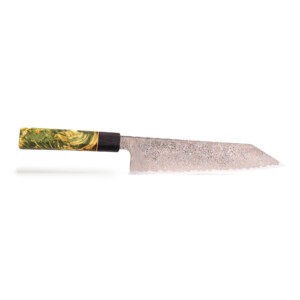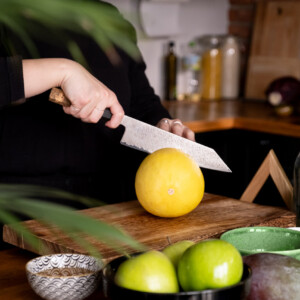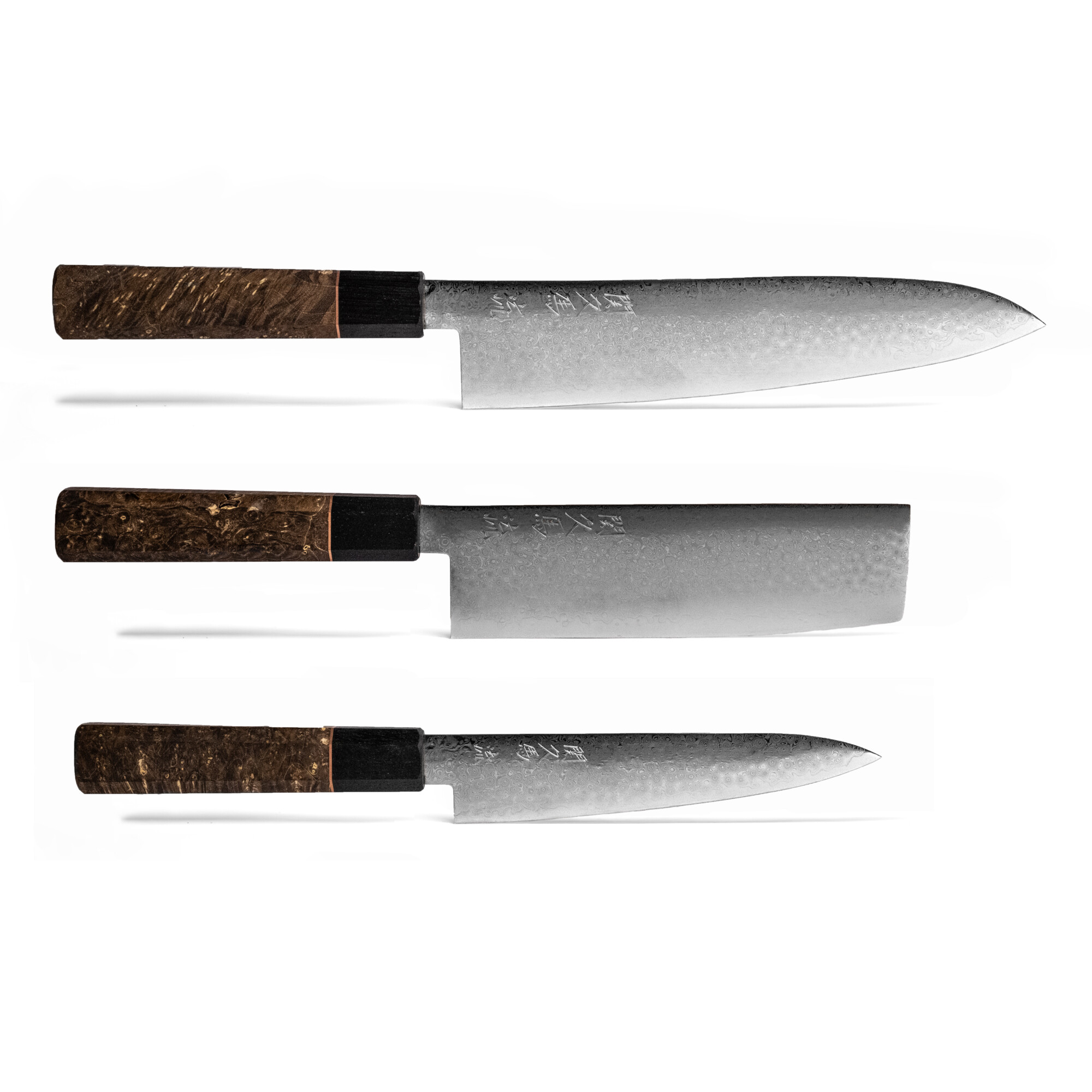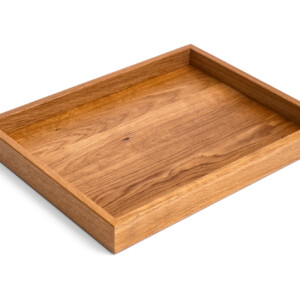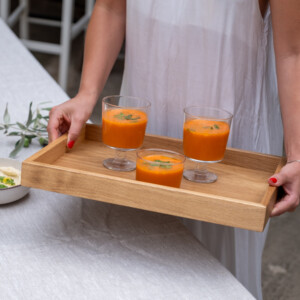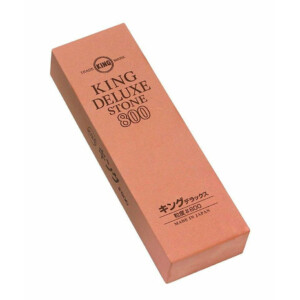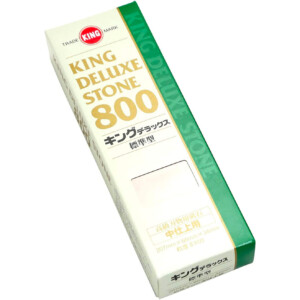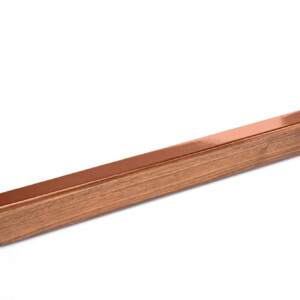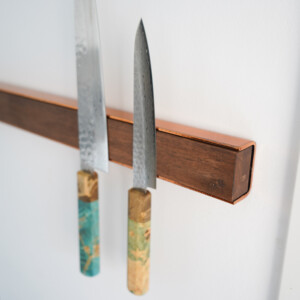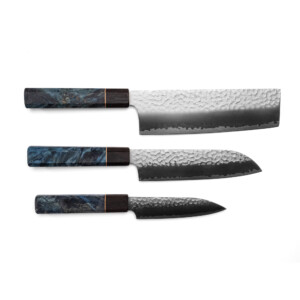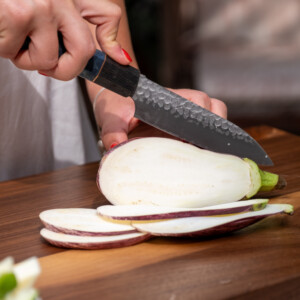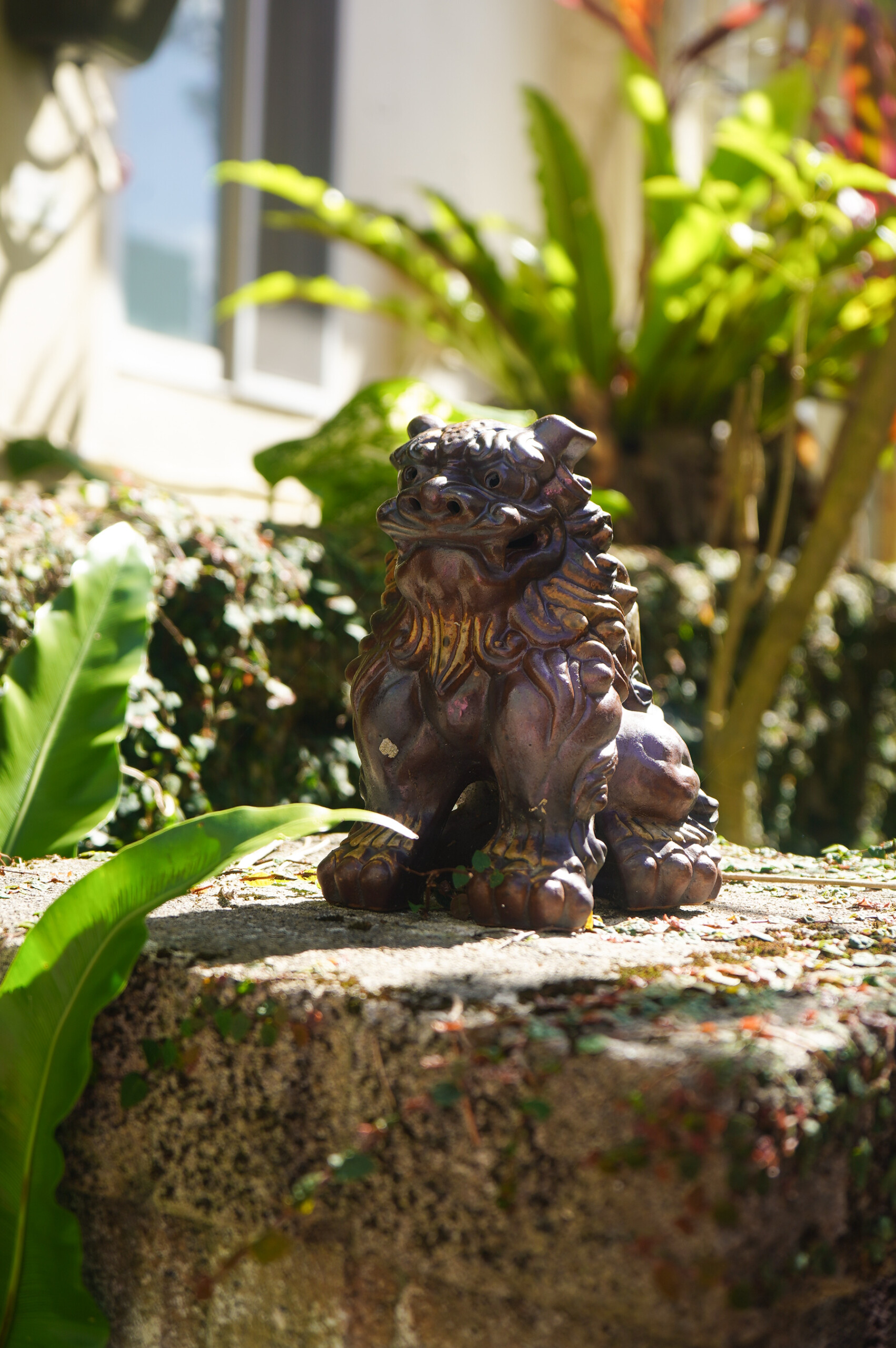Getting into Japanese knives is akin to discovering a world where culinary tradition meets artistic craftsmanship. As you start this new chapter, picture the countless meals, the bursts of creativity, and the sense of achievement that lie ahead. At Oishya, we believe that choosing the right knife isn’t just about picking a tool – it’s about finding an extension of yourself in the kitchen, a partner in your culinary exploration.
Japanese knives are famed worldwide for their exceptional quality, precision, and the unmatched experience they offer to both professional chefs and home cooks. But what sets these knives apart? It’s a blend of age-old traditions, innovative metallurgy, and a philosophy that views knife-making as an art form.
As we delve into Japanese knives, remember that this process is about more than just acquiring new tools. It’s about embracing the concepts of ikigai (finding your purpose), kaizen (continuous improvement), and wabi-sabi (finding beauty in imperfection). These principles will not only guide your choice and use of knives but can also inspire a more mindful and fulfilling approach to cooking and life.
The Essence of Japanese Knives:
1. Craftsmanship and Tradition: Japanese knife-making is steeped in a rich history dating back to the samurai era. The same techniques used to forge katana (samurai swords) were adapted to create kitchen knives, resulting in blades of unparalleled sharpness and durability. Today, many Japanese knives are still handcrafted by skilled artisans who have honed their craft over decades, passing down knowledge through generations.
2. Materials and Construction: Japanese knives are typically made from high-carbon steel, which allows for a sharper edge and better edge retention compared to stainless steel. However, many modern Japanese knives use advanced steel alloys that combine the benefits of high-carbon and stainless steel. The construction of these knives often involves a hard core of high-carbon steel sandwiched between layers of softer steel, a technique known as san mai. This results in a blade that is both incredibly sharp and more durable.
3. Sharpness and Edge Geometry: One of the defining features of Japanese knives is their acute edge angle, typically around 15-17 degrees per side, compared to the 20-22 degrees common in Western knives. This sharper angle allows for more precise cuts and less resistance when slicing through ingredients. The trade-off is that these edges require more careful maintenance and sharpening.
4. Specialisation: Unlike Western knife sets that often feature all-purpose knives, Japanese knives are highly specialised. Each knife is designed for a specific task, allowing for optimal performance in its intended use. This specialisation encourages cooks to develop a deeper understanding of their tools and ingredients, leading to more mindful and precise cooking.
5. Balance and Weight: Japanese knives are generally lighter and more nimble than their Western counterparts. This design philosophy emphasises precision and control over power, allowing for less fatigue during long cooking sessions and more delicate knife work.
Embracing the Japanese Knife Philosophy:
As you begin with Japanese knives, it’s important to approach them with the right mindset. Here are some principles to consider:
1. Mindfulness (Ikigai): Using a Japanese knife is an exercise in mindfulness. The act of choosing the right knife for each task, maintaining its edge, and using it with precision can become a form of meditation. This mindful approach not only improves your cooking but can also bring a sense of purpose and fulfilment to your time in the kitchen.
2. Continuous Improvement (Kaizen): Mastering the use of Japanese knives is a lifelong pursuit. Embrace the concept of kaizen by constantly seeking to improve your technique, expand your knowledge, and refine your skills. Each slice is an opportunity to learn and grow.
3. Embracing Imperfection (Wabi-Sabi): While Japanese knives are precision tools, the philosophy of wabi-sabi reminds us to find beauty in imperfection. Your experience will involve mistakes, uneven cuts, and learning moments. Embrace these as part of the process, finding joy in the continuous path of improvement rather than seeking an unattainable perfection.
4. Respect for Tools and Ingredients: In Japanese culinary tradition, there’s a deep respect for both the tools of the trade and the ingredients being prepared. Treat your knives with care, maintain them properly, and use them to honour the ingredients you’re working with. This respect will translate into more thoughtful, delicious cooking.
As we prepare to explore the specific types of Japanese knives, remember that each one is not just a tool, but a key to unlocking new culinary possibilities. In the following sections, we’ll delve into the unique characteristics, uses, and care instructions for each knife type shown in the image. Shall we?
Japanese Knife types and shapes:
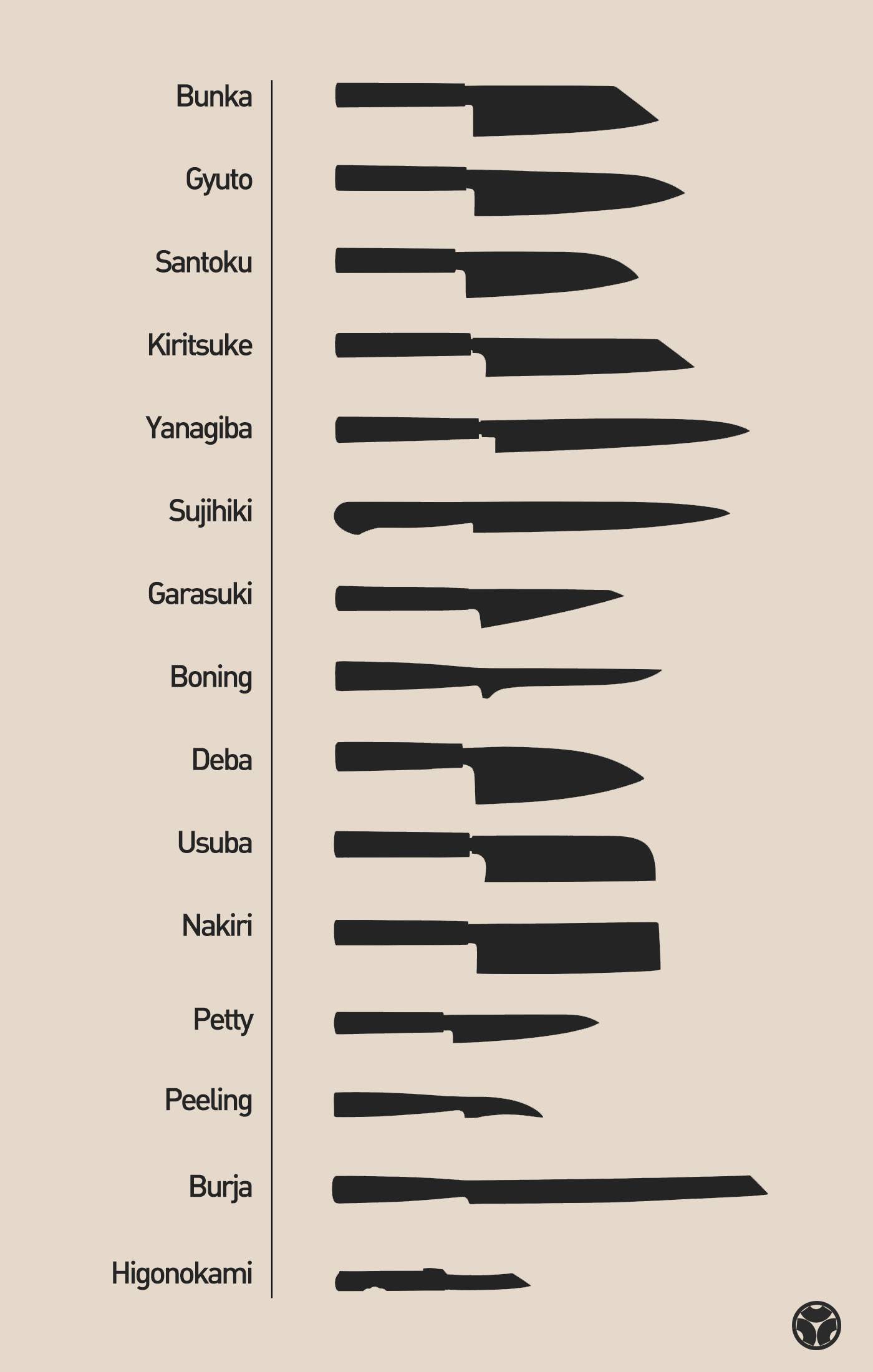
The Bunka
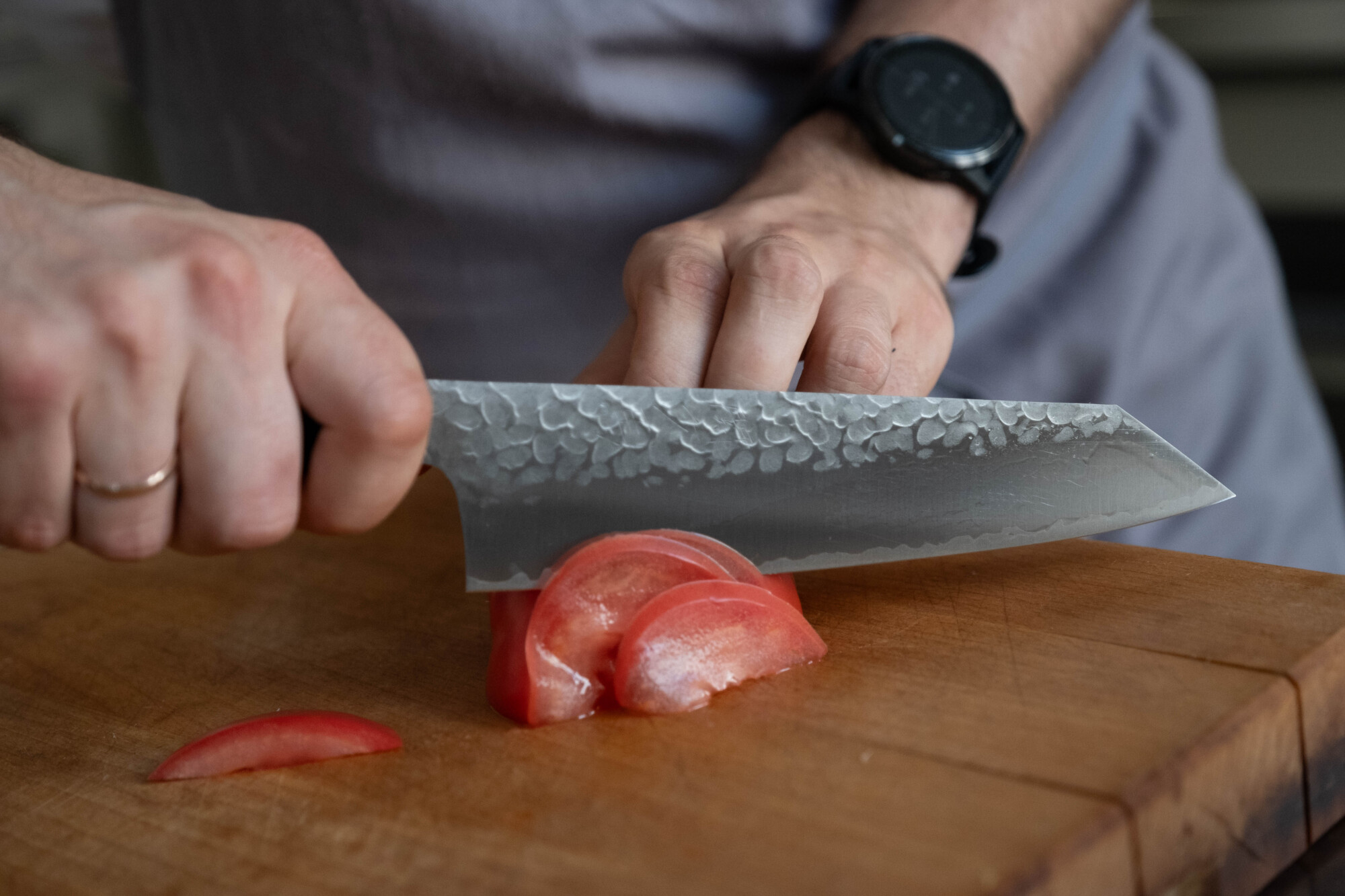
The Bunka, meaning “culture” in Japanese, is a versatile all-purpose knife that’s gaining popularity among home cooks and professional chefs alike.
Characteristics:
- Blade length: Typically 165-180mm
- Profile: Similar to a Santoku but with a triangular tip (often called a “reverse tanto” tip)
- Edge: Double-beveled
Uses:
The Bunka excels at a variety of tasks, making it an excellent choice for those looking to invest in their first Japanese knife. Its versatility allows it to handle:
- Chopping vegetables
- Slicing boneless meats
- Fine dicing of herbs
- Precise tip work for detailed cuts
The triangular tip of the Bunka gives it an advantage over the Santoku for more delicate work, allowing for improved control when making precise cuts or working with smaller ingredients.
Why choose a Bunka:
If you’re seeking a do-it-all knife that offers a bit more precision than a Santoku, the Bunka is an excellent choice. Its shape makes it particularly suitable for push-cutting techniques, where the knife is pushed forward in a straight motion, rather than rocked like a Western chef’s knife.
The Gyuto
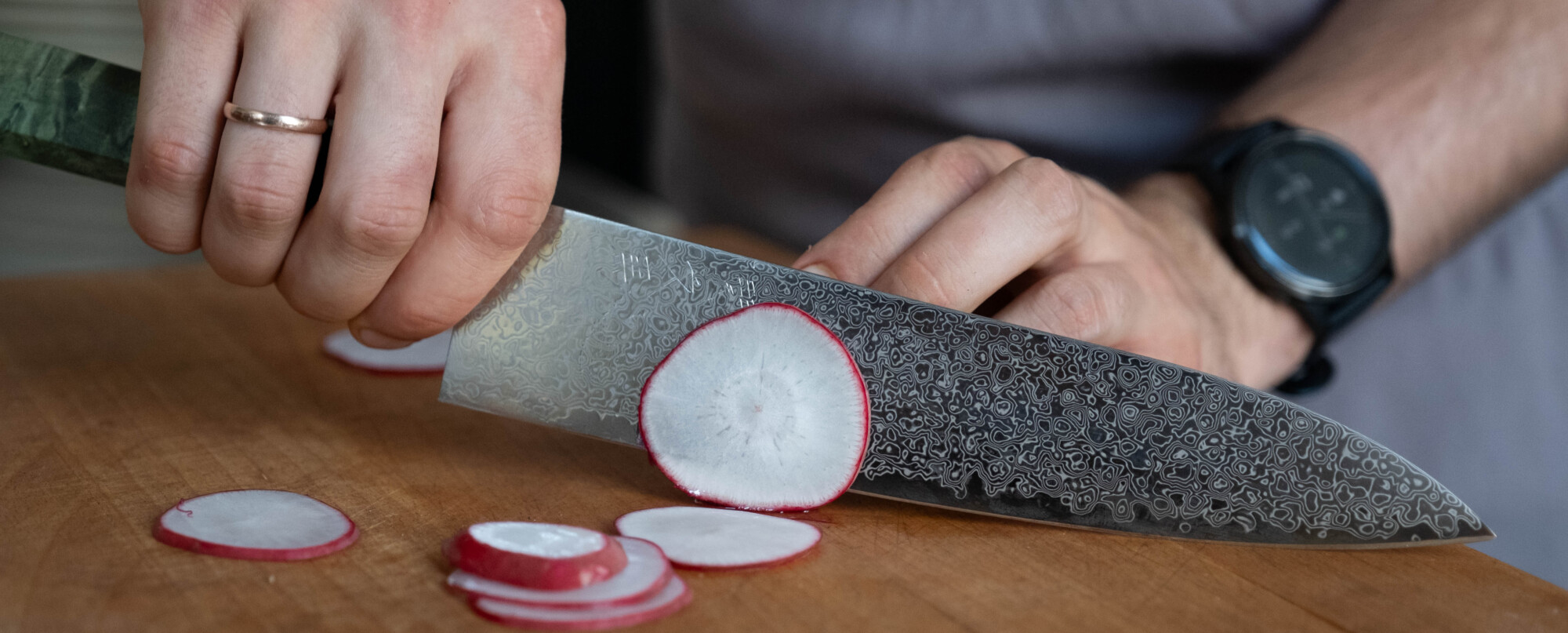
The Gyuto, which translates to “beef sword,” is the Japanese equivalent of a Western chef’s knife. It’s an all-purpose knife that can handle a wide range of tasks in the kitchen.
Characteristics:
- Blade length: Usually 180-270mm
- Profile: Curved blade with a pointed tip
- Edge: Double-beveled
Uses:
The Gyuto is prized for its versatility and is often considered the workhorse of the Japanese kitchen. It excels at:
- Slicing meat (as its name suggests)
- Chopping vegetables
- Rocking cuts for herbs
- Push-cutting techniques
The curved blade allows for a rocking motion similar to Western knives, while the typically thinner blade and more acute edge angle of Japanese knives provide enhanced cutting performance.
Why choose a Gyuto:
For those transitioning from Western-style knives to Japanese knives, the Gyuto offers a familiar shape with the added benefits of Japanese knife design. It’s an excellent all-rounder that can handle most kitchen tasks with ease.
The Santoku
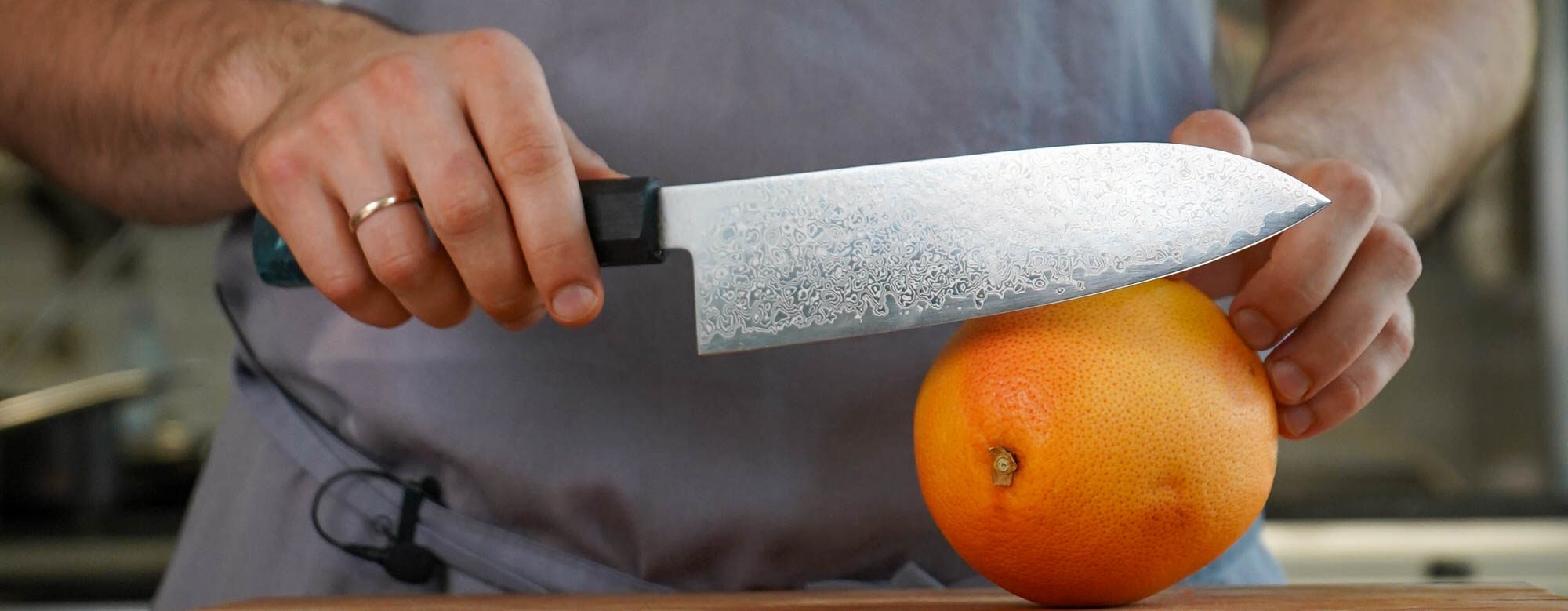
The Santoku, meaning “three virtues” or “three uses,” is a general-purpose kitchen knife originating in Japan. The name refers to its ability to handle meat, fish, and vegetables with equal proficiency.
Characteristics:
- Blade length: Typically 150-180mm
- Profile: Flat blade with a rounded tip
- Edge: Double-beveled
Uses:
The Santoku is designed for versatility and excels at:
- Slicing vegetables
- Cutting boneless or soft meats
- Chopping herbs
- Creating thin slices of cheese
The flat profile of the Santoku makes it particularly good for push-cutting techniques and allows for easy scooping of cut ingredients from the cutting board.
Why choose a Santoku:
If you prefer a shorter, lighter knife than a traditional chef’s knife, the Santoku is an excellent choice. Its versatility makes it popular among home cooks who want one knife that can handle most kitchen tasks. The shorter length also makes it more manageable for those with smaller hands or limited counter space.
The Kiritsuke
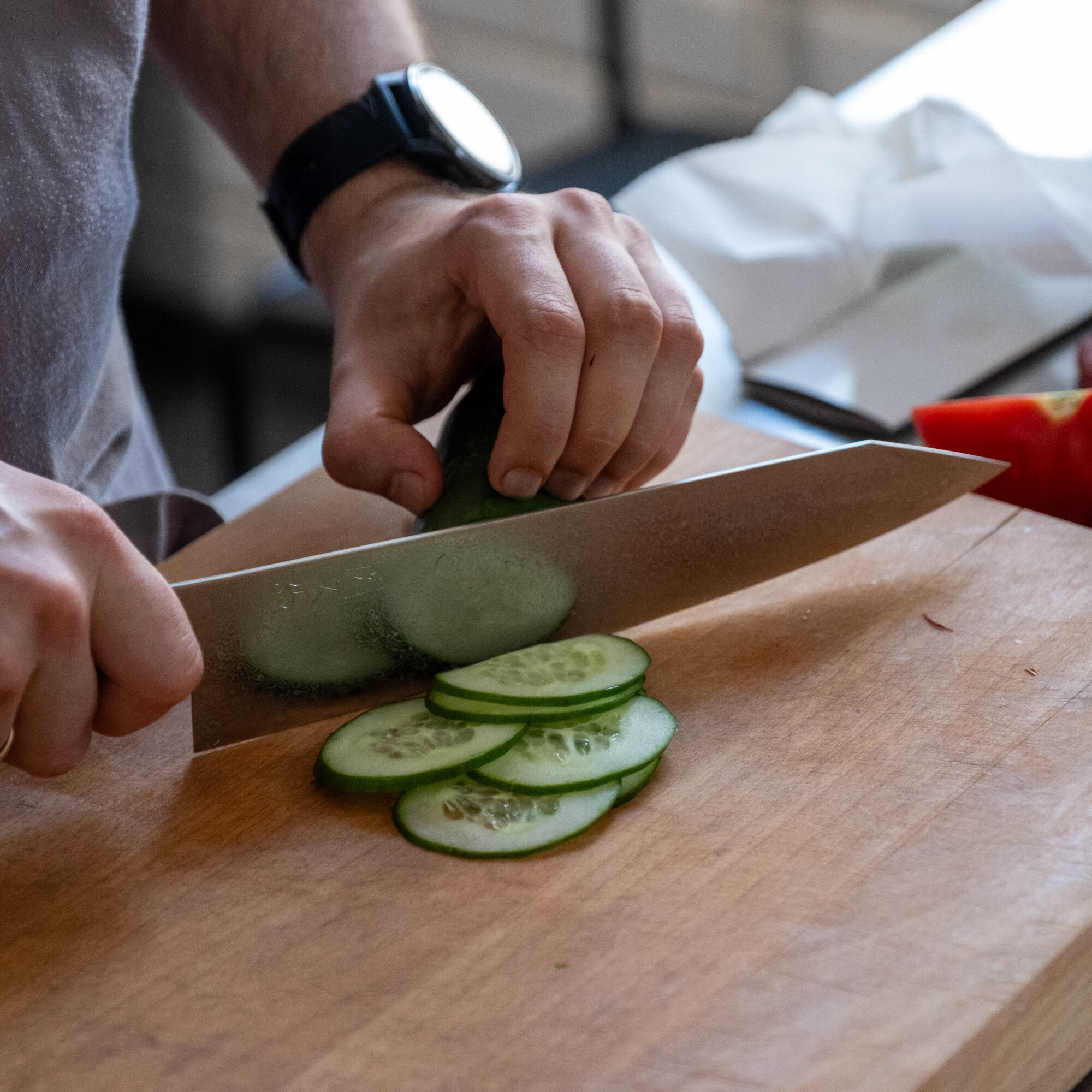
The Kiritsuke is a multi-purpose knife that combines elements of the Yanagiba (a slicer for raw fish) and the Usuba (a vegetable knife). In traditional Japanese kitchens, it was often reserved for executive chefs as a symbol of status and skill.
Characteristics:
- Blade length: Usually 240-300mm
- Profile: Long, straight blade with a angled tip
- Edge: Traditionally single-beveled, though double-beveled versions exist
Uses:
The Kiritsuke is a versatile knife that can be used for:
- Slicing raw fish for sashimi
- Cutting vegetables, especially for decorative cuts
- Slicing cooked proteins
- General prep work
The angled tip allows for precise cuts and can be particularly useful for intricate vegetable work.
Why choose a Kiritsuke:
The Kiritsuke is for those who appreciate versatility and are willing to invest time in mastering a more challenging knife. Its combination of slicing and chopping abilities makes it a favourite among chefs who want to minimise the number of knives they use. However, it requires skill to use effectively, making it a rewarding choice for those dedicated to improving their knife skills.
The Yanagiba
The Yanagiba, which translates to “willow blade,” is a long, slender knife primarily used for slicing raw fish for sashimi and sushi.
Characteristics:
- Blade length: Typically 240-360mm
- Profile: Long, narrow blade with a pointed tip
- Edge: Single-beveled
Uses:
The Yanagiba is highly specialized and is designed for:
- Slicing raw fish for sashimi and sushi
- Filleting fish
- Making long, unbroken cuts through delicate proteins
The single-beveled edge allows for incredibly thin, precise slices and helps separate flesh from skin with minimal cellular damage, preserving the texture and flavour of the fish.
Why choose a Yanagiba:
If you frequently prepare sushi or sashimi at home, or if you’re a professional working in Japanese cuisine, a Yanagiba is an essential tool. Its specialized design allows for the creation of pristine slices of fish that are crucial for these dishes. However, its narrow focus means it’s not typically a first choice for home cooks looking for a general-purpose knife.
The Sujihiki
The Sujihiki, meaning “muscle slicer,” is a long, thin slicing knife designed for cutting meat.
Characteristics:
- Blade length: Usually 240-300mm
- Profile: Long, narrow blade with a pointed tip
- Edge: Double-beveled
Uses:
The Sujihiki excels at:
- Slicing cooked meats
- Trimming fat and sinew from raw meats
- Portioning large fish
Its long, narrow blade allows for smooth, uninterrupted cuts, making it ideal for producing thin slices of meat with minimal sawing motion.
Why choose a Sujihiki:
If you frequently cook and serve large roasts, hams, or whole fish, a Sujihiki will make portioning and serving much easier. It’s also an excellent choice for those who prefer a double-beveled alternative to the traditional single-beveled Yanagiba.
The Garasuki
The Garasuki is a sturdy, triangular-shaped knife designed specifically for breaking down poultry.
Characteristics:
- Blade length: Typically 150-180mm
- Profile: Thick, triangular blade with a pointed tip
- Edge: Double-beveled
Uses:
The Garasuki is specialised for:
– Butchering whole poultry
– Cutting through small bones and joints
– Trimming and portioning chicken parts
Its robust construction allows it to handle the tougher tasks involved in poultry preparation without damaging the blade.
Why choose a Garasuki:
If you frequently work with whole poultry, either in a professional setting or as an enthusiastic home cook, the Garasuki offers precision and power that a general-purpose knife can’t match. However, its specialised nature means it’s not typically a priority for most home kitchens.
The Boning knife
While not traditionally Japanese, many Japanese knife makers produce excellent boning knives.
Characteristics:
- Blade length: Usually 130-170mm
- Profile: Narrow blade with a sharp, pointed tip
- Edge: Double-beveled
Uses:
A boning knife is designed for:
- Separating meat from bones
- Trimming fat and sinew
- Butterflying cuts of meat
The narrow blade and sharp tip allow for precise cuts around bones and joints, minimising waste.
Why choose a boning knife:
If you often work with bone-in meats or enjoy preparing your own cuts from larger pieces, a boning knife is invaluable. It allows for more precise and efficient butchery than a general-purpose knife.
The Deba
The Deba is a thick, heavy knife primarily used for breaking down whole fish.
Characteristics:
- Blade length: Typically 150-210mm
- Profile: Thick, heavy blade with a pointed tip
- Edge: Single-beveled
Uses:
The Deba is specialised for:
- Filleting and portioning whole fish
- Cutting through small fish bones
- Beheading fish
Its robust construction allows it to handle the sometimes tough work of breaking down fish without damaging the blade.
Why choose a Deba:
If you frequently work with whole fish, either as a professional or an enthusiastic home cook, a Deba offers precision and power that a general-purpose knife can’t match. However, its specialised nature means it’s not typically a priority for most home kitchens.
The Usuba
The Usuba, meaning “thin blade,” is a specialised vegetable knife.
Characteristics:
- Blade length: Usually 180-210mm
- Profile: Thin, rectangular blade with a straight edge
- Edge: Single-beveled
Uses:
The Usuba is designed for:
- Precise vegetable cutting
- Creating sheets or thin slices of vegetables
- Intricate vegetable carving and decorative cuts
Its thin, flat blade allows for extremely precise cuts and is particularly good for push-cutting techniques.
Why choose an Usuba:
If you’re passionate about Japanese cuisine or vegetable preparation, an Usuba offers unparalleled precision for vegetable work. However, its single-beveled edge requires proper technique and may not be suitable for beginners.
The Nakiri
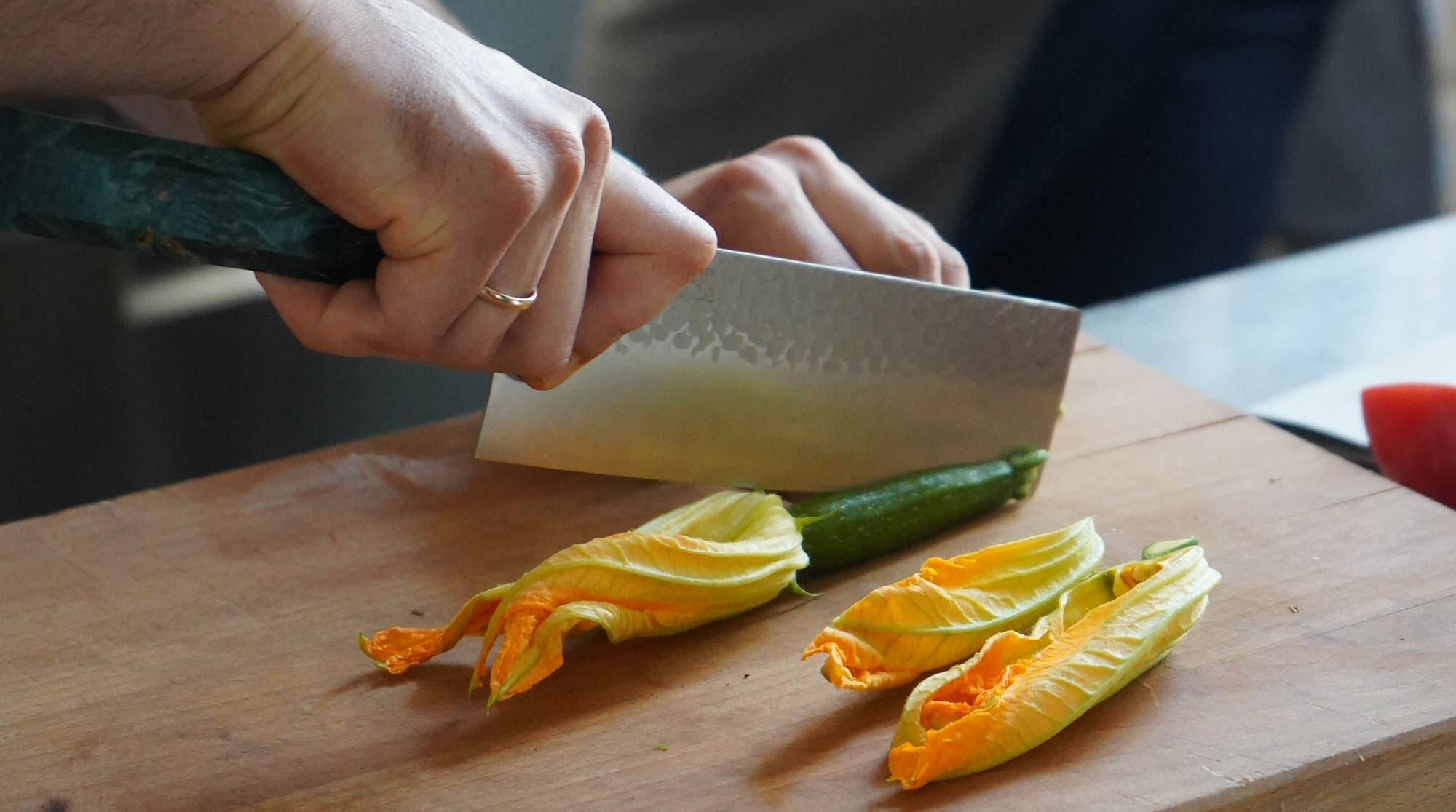
The Nakiri is a double-beveled alternative to the Usuba, designed for vegetable preparation.
Characteristics:
- Blade length: Typically 160-180mm
- Profile: Thin, rectangular blade with a straight edge
- Edge: Double-beveled
Uses:
The Nakiri excels at:
- Chopping and slicing vegetables
- Creating uniform cuts
- Push-cutting techniques
Its straight edge allows for clean cuts through vegetables, making it easy to create uniform pieces.
Why choose a Nakiri:
If you prepare a lot of vegetables and want a knife specifically designed for this task, a Nakiri is an excellent choice. It’s easier to use than the single-beveled Usuba while still offering excellent performance for vegetable preparation.
The Petty (Pairing knife):

The Petty knife is a smaller, more versatile knife, similar to a Western paring knife but often slightly larger.
Characteristics:
- Blade length: Usually 120-150mm
- Profile: Small, pointed blade
- Edge: Double-beveled
Uses:
The Petty knife is great for:
- Precise cuts on smaller ingredients
- Peeling and trimming fruits and vegetables
- Light meat and fish preparation
- In-hand work
Its small size makes it highly manoeuvrable, perfect for detailed work or when a larger knife would be unwieldy.
Why choose a Petty:
A Petty knife is an excellent complement to a larger chef’s knife or Gyuto. Its versatility makes it useful for a wide range of smaller tasks, making it a valuable addition to any kitchen.
The Peeling knife
While not a traditional Japanese knife, many Japanese makers produce excellent peeling knives.
Characteristics:
- Blade length: Typically 70-100mm
- Profile: Short blade with a curved edge
- Edge: Double-beveled
Uses:
A peeling knife is designed for:
– Peeling fruits and vegetables
– Removing blemishes from produce
– Detailed decorative work
Its small size and curved blade make it perfect for working with round fruits and vegetables.
Why choose a peeling knife:
If you frequently peel large quantities of fruits or vegetables, a dedicated peeling knife can make the task much faster and more comfortable than using a paring knife or vegetable peeler.
The Burja
The Burja (also spelled Burja or Bujja) is a traditional Japanese knife with a long, narrow blade.
Characteristics:
- Blade length: Can vary, but often quite long (300mm+)
- Profile: Long, narrow blade with a slight curve
- Edge: Usually single-beveled
Uses:
The Burja is typically used for:
- Slicing very thin sheets of ingredients
- Precise cuts in delicate foods
- Some specialised food preparation techniques
Its long, narrow blade allows for extremely thin, precise cuts.
Why choose a Burja:
The Burja is a highly specialised knife that’s not commonly found in most kitchens. It’s typically used by professionals or very dedicated home cooks who need to make extremely precise, thin cuts.
The Higonokami
The Higonokami is not a kitchen knife, but a traditional Japanese folding pocket knife.
Characteristics:
- Blade length: Usually 70-120mm
- Profile: Folding knife with a simple friction folder mechanism
- Edge: Single-beveled
Uses:
While not designed for kitchen use, a Higonokami can be used for:
- Light cutting tasks
- Opening packages
- As a general utility knife
Its compact, folding design makes it easy to carry.
Why choose a Higonokami:
While not suitable for serious kitchen work, a Higonokami can be a useful tool to have on hand for small tasks. Its traditional design and craftsmanship also make it an interesting collector’s item for those interested in Japanese knife making.
Japanese knives offer a wide range of specialised tools, each designed to excel at specific tasks. By understanding the unique characteristics and uses of each knife type, you can choose the right tools to elevate your culinary skills and enjoy the precision and craftsmanship that Japanese knives offer. Remember, mastering these knives is a journey of continuous improvement, embodying the Japanese principle of kaizen. With practice and dedication, you’ll find that these knives not only improve your cooking but also bring a sense of mindfulness and respect to your time in the kitchen.










